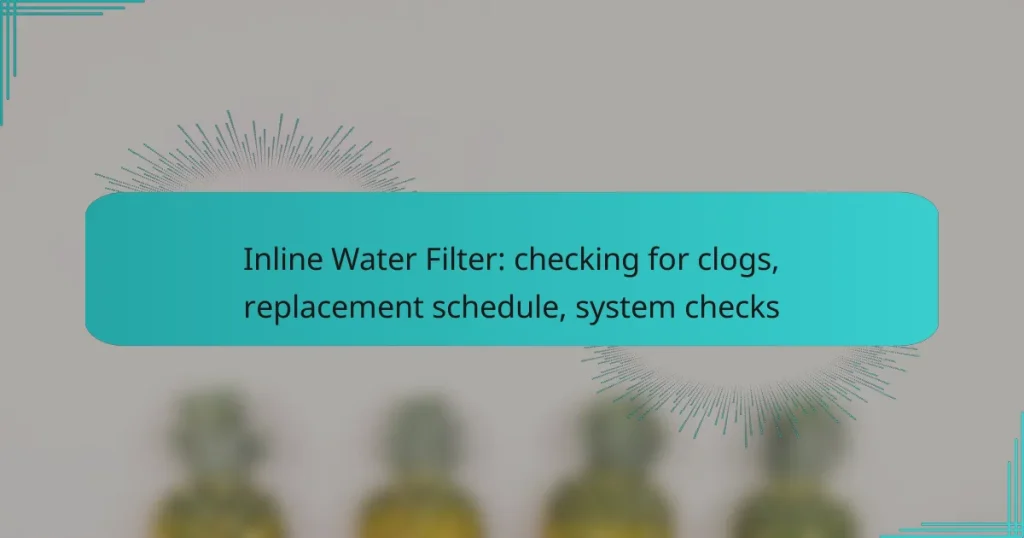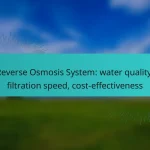Maintaining an inline water filter is crucial for ensuring clean and safe drinking water. Regular checks for clogs, adherence to a replacement schedule, and routine system assessments can significantly enhance the filter’s performance and longevity. By monitoring flow rates and inspecting for leaks, you can ensure that your water filtration system operates efficiently and effectively.

How to check for clogs in an inline water filter?
To check for clogs in an inline water filter, perform a combination of visual inspections, flow rate measurements, and pressure gauge readings. These methods help identify blockages that can reduce water quality and flow efficiency.
Visual inspection for debris
Start by visually inspecting the filter and its surrounding area for any visible debris or buildup. Look for sediment, discoloration, or any foreign materials that may indicate clogging. If the filter appears dirty or discolored, it may be time for a replacement.
Additionally, check the inlet and outlet connections for any signs of leaks or obstructions. Regular visual checks can help catch issues early, preventing more significant problems down the line.
Flow rate measurement
Measuring the flow rate is a practical way to assess filter performance. Use a container with a known volume and time how long it takes to fill it with water from the filter. A significant decrease in flow rate compared to the manufacturer’s specifications may indicate a clog.
As a general guideline, if the flow rate is noticeably lower than usual, consider checking for clogs or replacing the filter. Regular flow rate checks can help maintain optimal water quality.
Pressure gauge readings
Using a pressure gauge can provide insight into the condition of your inline water filter. Install a gauge at the inlet and outlet of the filter to monitor pressure differences. A significant drop in pressure from inlet to outlet often signifies a clog.
For effective monitoring, check pressure readings regularly, especially if you notice changes in flow rate. Keeping track of these readings can help you determine when maintenance or replacement is necessary, ensuring your water system operates efficiently.

What is the replacement schedule for inline water filters?
The replacement schedule for inline water filters typically ranges from six months to two years, depending on usage and water quality. Regularly replacing these filters ensures optimal performance and safe drinking water.
Manufacturer recommendations
Manufacturers usually provide specific guidelines for replacing inline water filters, which can vary by model and brand. It’s essential to consult the user manual or product specifications for the recommended replacement frequency to maintain warranty coverage and system efficiency.
Many manufacturers suggest replacing filters every 6 to 12 months, particularly in areas with hard water or high sediment levels. Following these recommendations helps prevent clogs and ensures consistent water quality.
Usage frequency guidelines
The frequency of filter replacement can also depend on how often the water system is used. For households with heavy water usage, such as large families or homes with multiple appliances, more frequent replacements may be necessary.
A good rule of thumb is to monitor the water flow rate and taste. If you notice a decrease in flow or a change in taste, it may be time to replace the filter, regardless of the elapsed time since the last change.

What system checks should be performed regularly?
Regular system checks for inline water filters are essential to ensure optimal performance and water quality. These checks typically include assessing filter integrity and detecting any leaks in the system.
Filter integrity assessment
To assess filter integrity, inspect the filter for any visible signs of wear or damage. A good practice is to check the filter’s pressure gauge, if available, as a significant drop in pressure can indicate clogging or a need for replacement.
Replace filters according to the manufacturer’s recommendations, which is often every six months to a year, depending on usage and water quality. Keeping a log of replacement dates can help maintain a consistent schedule.
Leak detection procedures
Leak detection involves regularly inspecting the connections and hoses for any signs of moisture or water pooling. Use a dry cloth to wipe down connections and check for dampness, which can indicate a leak.
In case of a suspected leak, tighten connections and replace any damaged hoses. It’s advisable to conduct these checks at least once a month to prevent water damage and ensure system efficiency.

How to choose the right inline water filter?
Choosing the right inline water filter involves considering the specific contaminants you want to remove, the filter’s capacity, and its compatibility with your plumbing system. It’s essential to evaluate your water quality and select a filter that meets your needs effectively.
Filter type comparison
Inline water filters come in various types, including activated carbon, reverse osmosis, and ceramic filters. Activated carbon filters are effective for removing chlorine and improving taste, while reverse osmosis filters can eliminate a broader range of contaminants, including heavy metals and bacteria.
When comparing filter types, consider the flow rate and lifespan. For instance, activated carbon filters typically last for several months, while reverse osmosis systems may require more frequent maintenance due to their complex setup. Assess your water usage to determine which type aligns best with your household needs.
Brand reliability evaluation
Evaluating brand reliability is crucial when selecting an inline water filter. Look for brands that have established a strong reputation for quality and customer service. Reading customer reviews and checking for certifications, such as NSF/ANSI standards, can provide insight into a brand’s reliability.
Additionally, consider the warranty and support offered by the manufacturer. A reliable brand often provides a reasonable warranty period and responsive customer service, ensuring you can get assistance if issues arise. Researching brands that have been in the market for several years can also indicate their trustworthiness and product performance.

What are the signs of a failing inline water filter?
Signs of a failing inline water filter include unusual taste or odor in the water and reduced water pressure. These indicators suggest that the filter may be clogged or nearing the end of its useful life, requiring immediate attention.
Unusual taste or odor
If your water has a strange taste or odor, it may indicate that the inline water filter is not functioning properly. Common issues include the presence of chlorine, sediment, or bacteria that the filter is unable to remove effectively.
To assess the situation, fill a glass with water and smell it. If you detect any off-putting scents, consider replacing the filter. Regularly checking for changes in taste or odor can help maintain water quality.
Reduced water pressure
A noticeable drop in water pressure can signal that your inline water filter is clogged. When the filter becomes saturated with contaminants, it restricts water flow, leading to weaker pressure at the tap.
To troubleshoot, compare the current water pressure to normal levels. If the pressure is significantly lower, it may be time to inspect and possibly replace the filter. Regular maintenance can prevent pressure issues and ensure consistent water flow.

How to maintain an inline water filter?
Maintaining an inline water filter involves regular checks for clogs, adhering to a replacement schedule, and performing system checks to ensure optimal performance. Proper maintenance helps extend the filter’s lifespan and ensures clean water delivery.
Regular cleaning procedures
Regular cleaning of your inline water filter is essential to prevent clogs and maintain water quality. Depending on your water source, cleaning may be necessary every few months or more frequently if you notice reduced flow rates.
To clean the filter, first turn off the water supply and disconnect the filter. Rinse the filter under running water to remove any debris. If the filter is heavily soiled, consider soaking it in a vinegar solution for a few hours before rinsing again.
Proper installation techniques
Proper installation of an inline water filter is crucial for its effectiveness and longevity. Ensure that the filter is installed according to the manufacturer’s instructions, paying attention to the direction of water flow indicated on the unit.
Use high-quality fittings and ensure all connections are tight to prevent leaks. If you are unsure about the installation process, consult a professional plumber to avoid common pitfalls that could lead to system failures or contamination.

What are the benefits of inline water filters?
Inline water filters provide clean, safe drinking water directly from your tap, enhancing taste and quality. They are convenient, often requiring minimal maintenance while effectively reducing contaminants like chlorine, sediment, and heavy metals.
Space-saving design
Inline water filters are designed to fit seamlessly into existing plumbing systems, taking up minimal space. This compact design allows for installation under sinks or in tight areas without requiring bulky equipment or extensive modifications.
Many models can be mounted directly on the water line, making them ideal for homes with limited under-sink space. Their unobtrusive nature means they can be easily integrated into your kitchen or bathroom without disrupting aesthetics.
When selecting an inline water filter, consider the dimensions and installation requirements to ensure it fits your specific space. Look for options that offer flexible mounting solutions to maximize efficiency and convenience.


